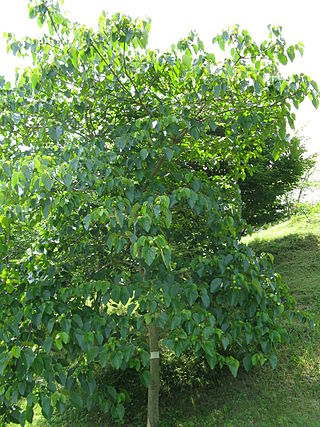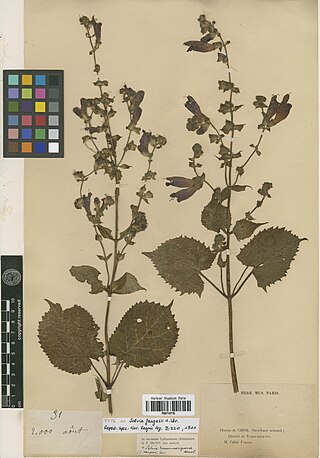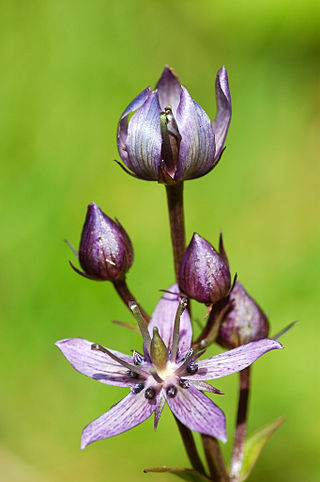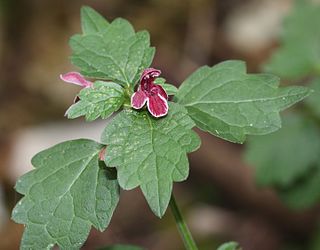
Honeysuckles are arching shrubs or twining vines in the genus Lonicera of the family Caprifoliaceae. It includes 158 species native to northern latitudes in North America, Eurasia, and North Africa. Widely known species include Lonicera periclymenum, Lonicera japonica and Lonicera sempervirens. L. japonica is a highly invasive species considered a significant pest in parts of North America, Europe, South America, Australia, and Africa.

Vernicia fordii is a species of flowering plant in the spurge family Euphorbiaceae. It is native to southern China, Myanmar, and northern Vietnam. It is a small to medium-sized deciduous tree growing to 20 m tall, with a spreading crown. The bark is smooth and thin, and bleeds latex if cut. The leaves are alternate, simple, 4.5–25 cm long and 3.5–22 cm broad, heart-shaped or with three shallow, maple-like lobes, green above and below, red conspicuous glands at the base of the leaf, and with a 5.5–26 cm long petiole. The flowers are 2.5–3.5 cm diameter, with five pale pink to purple petals with streaks of darker red or purple in the throat; it is monoecious with individual flowers either male or female, but produced together in the inflorescences. The flowers appear before or with the leaves in loose, terminal clusters. The fruit is a hard, woody pear-shaped berry 4–6 cm long and 3–5 cm diameter, containing four or five large, oily seeds; it is green initially, becoming dull brown when ripe in autumn.
Dalbergia glomerata is a species of legume in the family Fabaceae. It is found only in Mexico.
Quararibea pterocalyx, the wild palm or cinco dedos, is a species of flowering plant in the family Malvaceae. It is found in Colombia, Costa Rica, Panama, and Venezuela. It is threatened by habitat loss.

Swertia is a genus in the gentian family containing plants sometimes referred to as the felworts. Some species bear very showy purple and blue flowers. Many members of this genus have medicinal and cultural purposes.
Scalesia retroflexa is a species of flowering plant in the family Asteraceae. It is found only in the Galápagos Islands of Ecuador. It is threatened by habitat loss.
Excoecaria benthamiana is a species of flowering plant in the family Euphorbiaceae. It is endemic to Seychelles.
Polyscias crassa is a species of plant in the family Araliaceae. It is endemic to Seychelles. It is threatened by habitat loss.

Ginoria nudiflora is a species of flowering plant in the family Lythraceae. It is endemic to Mexico.

Dalbergia retusa is a plant species in the familyFabaceae . It is found in Pacific regions of Central America, ranging from Panama to southwestern Mexico. It produces the cocobolo wood. It is a fair-sized tree, reported to reach 20–25 m in height. This is probably the species contributing most of the wood in the trade. Because of the wood's great beauty and high value, the trees yielding this wood have been heavily exploited and are now rare outside national parks, reserves, and plantations.

A xanthonoid is a chemical natural phenolic compound formed from the xanthone backbone. Many members of the Clusiaceae contain xanthonoids.

Salvia maximowicziana is a perennial plant in the family Lamiaceae. It is found growing on grasslands, forests, and forest edges in China, at 1,800 to 3,300 m elevation. It grows 10 to 90 cm tall, with circular-cordate to ovate-cordate leaves that are typically 3 to 8 cm long and 6 to 8 cm wide. The upper leaf surface is nearly smooth, or lightly covered with hairs, while the underside has glandular hairs on the veins.

Swertia perennis is a species of flowering plant in the gentian family known by the common names felwort and star swertia. It is native to several regions of the northern hemisphere, including much of Eurasia and western North America. It is a plant of wetlands, particularly calcareous fens. It is common to abundant in many areas, but it is known to be negatively impacted by habitat fragmentation and other habitat destruction, and human activity has led to its extirpation from some areas where it was once common. It is a perennial herb producing usually one erect stem growing 10 to 50 centimeters tall. The basal leaves are spoon-shaped with rounded tips, and leaves higher on the plant are widely lance-shaped or somewhat oval, with pointed tips. The inflorescence is an open panicle of flowers atop the stem. Each flower has a calyx of four or five pointed sepals and a corolla of four or five pointed lobes each up to 1.3 centimeters long. The corolla is dull blue to violet in color with darker purplish veining or stippling. There are two rounded nectary pits at the base of each lobe of the corolla. Stamens tipped with large anthers surround a central ovary.

Cornus controversa, syn. Swida controversa, is a species of flowering plant in the dogwood family Cornaceae. It is native to China, Korea, the Himalayas and Japan. It is a deciduous tree growing to 50 ft (15 m), with multiple tiered branches. Flat panicles of white flowers appear in summer, followed by globose black fruit. Ovate dark green leaves are glaucous underneath and turn red-purple in autumn. It is cultivated in gardens and parks in temperate regions.

Lobelia rhynchopetalum, the giant lobelia, is a flowering plant in the family Campanulaceae. It is endemic to Ethiopia. Its habitat is the Afroalpine climate of the Semien Mountains and Bale Mountains National Park. Recent study show that it is under a threat of climate change.

Rhododendron concinnum (秀雅杜鹃) is a species of flowering plant in the family Ericaceae. It is native to Guizhou, Henan, Hubei, Shaanxi, Sichuan, and Yunnan in China, where it grows at altitudes of 2300–3000 meters. It is a shrub that grows to 1.5–3 m in height, with leaves that are oblong, elliptic, ovate, oblong-lanceolate or ovate-lanceolate, 2.5–7.5 by 1.5–3.5 cm in size. Flowers are pale pink to deep purplish red.

Loxocalyx is a genus of plants in the family Lamiaceae, first described in 1891. It is native to China and Japan.

Sterculia murexHemsl. or lowveld chestnut is a southern African tree in the family Malvaceae. It has a very limited distribution in the lowveld of eastern Mpumalanga and Eswatini. After S. alexandri it is the most southern representative of the genus in Africa. Kew currently recognises some 92 species of Sterculia, confined to the tropics and slightly beyond at low elevations.

Fraxinus malacophylla is a species of ash tree in the family Oleaceae. It is native to China, where it is found in Guangxi and Yunnan provinces, and Thailand.

Lycorma imperialis is a planthopper indigenous to parts of China and Indo-Malaysia. L. imperialis was originally discovered in 1846 by Adam White and has one recognized non-nominate subspecies, L. i. punicea. L. imperialis has undergone a number of reclassifications since its discovery and is one of four species in the genus Lycorma. L. imperialis follows a hemimetabolous life cycle and will undergo a series of nymphal stages (instars) before maturing to an adult.














